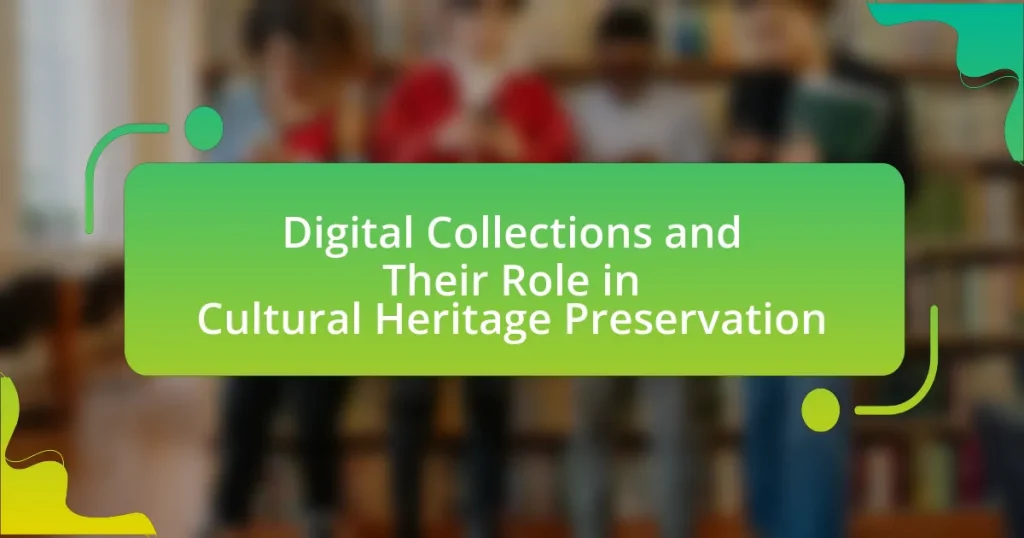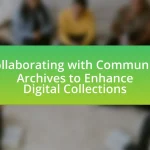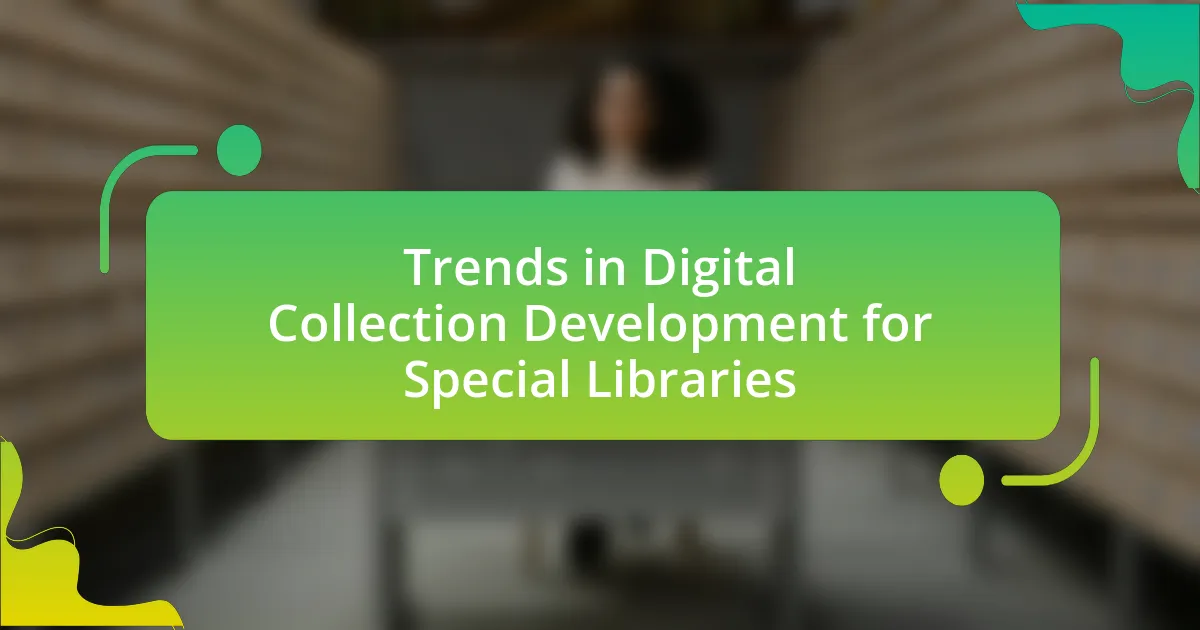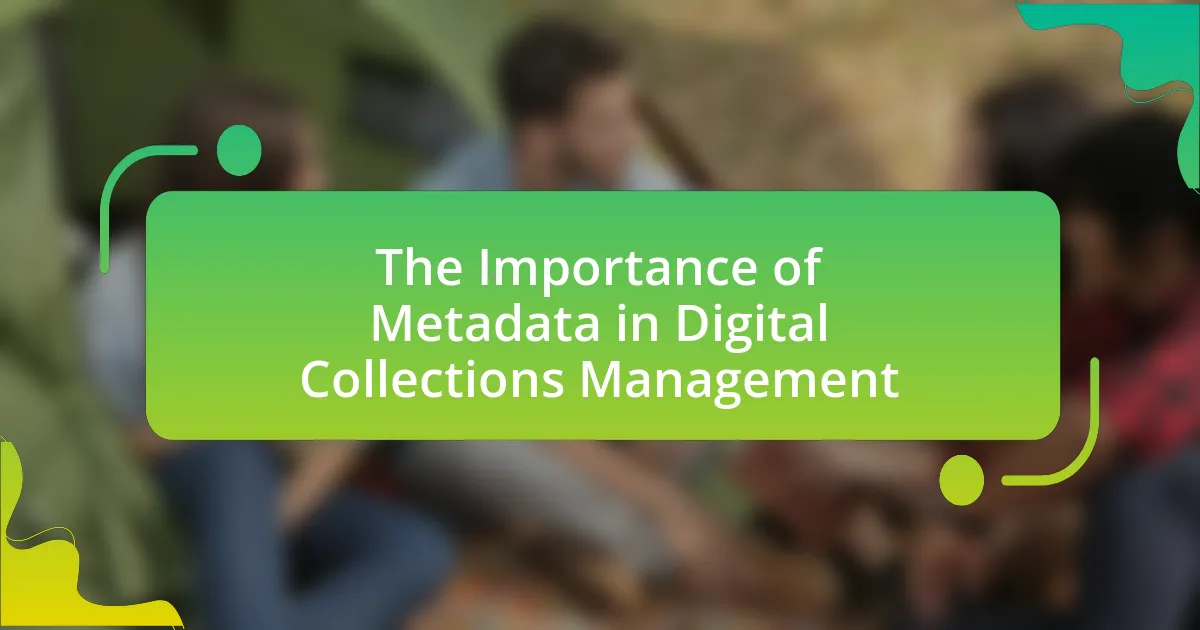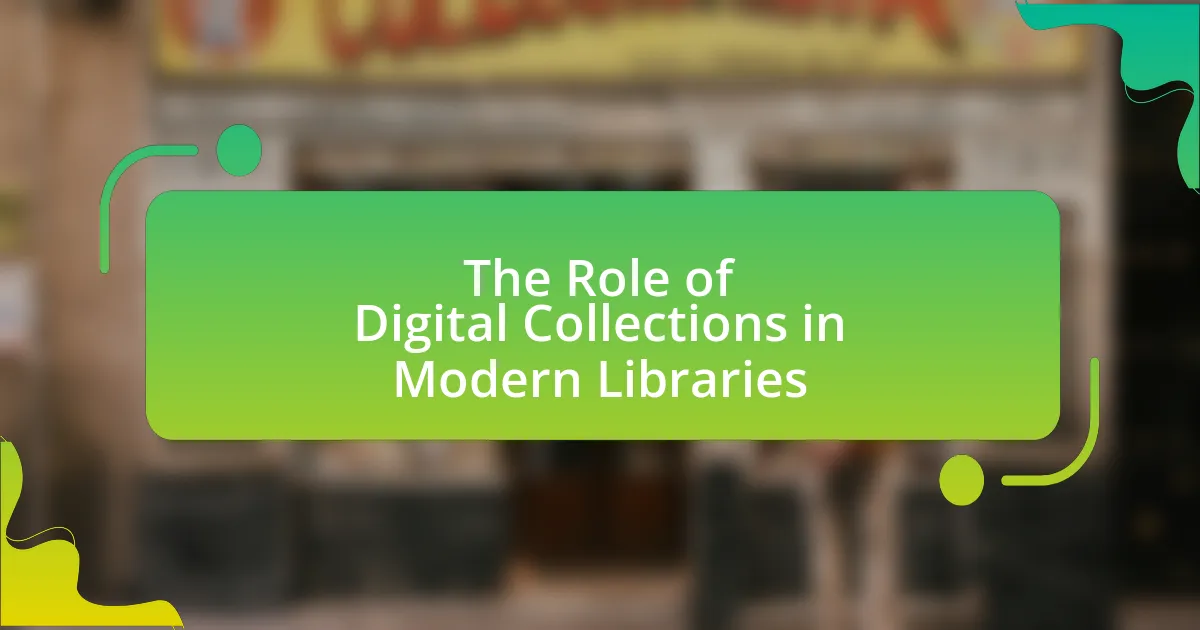Digital collections are curated groups of digital objects that encompass various forms of cultural heritage, including texts, images, audio, and video. They play a crucial role in preserving cultural heritage by providing accessible, long-term storage for artifacts that may be at risk of loss due to deterioration or disasters. The article explores how digital collections contribute to the preservation of tangible and intangible cultural heritage, enhance accessibility for global audiences, and serve as vital resources for education and research. It also addresses the technologies used in creating these collections, the challenges faced in their development, and best practices for their management and promotion, emphasizing the importance of community engagement and effective metadata in ensuring their sustainability and relevance.
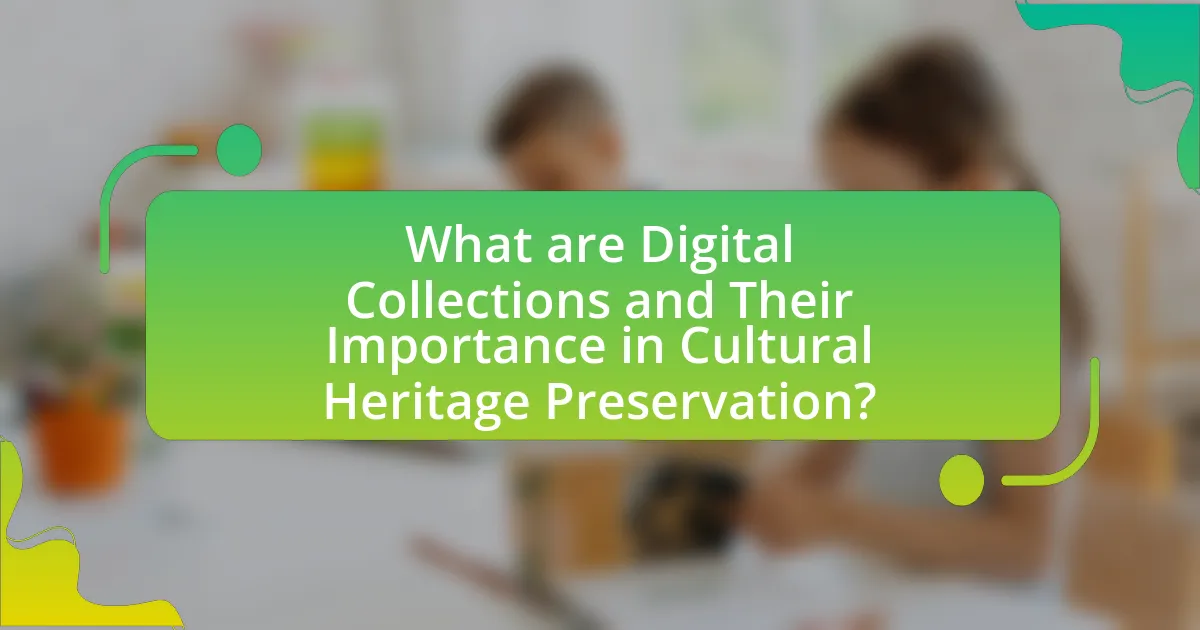
What are Digital Collections and Their Importance in Cultural Heritage Preservation?
Digital collections are curated groups of digital objects that represent cultural heritage, including texts, images, audio, and video. Their importance in cultural heritage preservation lies in their ability to provide accessible, long-term storage of artifacts that might otherwise be lost due to deterioration, natural disasters, or other threats. For instance, the Library of Congress has digitized millions of items, making them available to a global audience, which enhances public engagement and education while safeguarding the original materials. This digital preservation ensures that future generations can access and study cultural heritage, thereby maintaining historical continuity and fostering cultural understanding.
How do Digital Collections contribute to the preservation of cultural heritage?
Digital collections significantly contribute to the preservation of cultural heritage by providing accessible, digitized records of artifacts, documents, and traditions. These collections enable the safeguarding of cultural materials against physical deterioration, loss, or destruction, as evidenced by initiatives like the Library of Congress’s digitization projects, which have preserved millions of historical documents and photographs. Furthermore, digital collections facilitate global access, allowing diverse audiences to engage with cultural heritage, exemplified by platforms such as Europeana, which aggregates millions of digitized items from European cultural institutions. This accessibility not only enhances educational opportunities but also fosters cultural exchange and understanding, reinforcing the importance of preserving cultural heritage in a digital age.
What types of cultural heritage can be preserved through digital collections?
Digital collections can preserve various types of cultural heritage, including tangible artifacts, intangible cultural expressions, historical documents, audiovisual materials, and traditional knowledge. Tangible artifacts, such as artworks and archaeological finds, can be digitized to maintain their details and context. Intangible cultural expressions, like music, dance, and oral traditions, can be recorded and shared digitally, ensuring their transmission across generations. Historical documents, including manuscripts and letters, can be scanned and archived, providing access to primary sources. Audiovisual materials, such as films and recordings, can be digitized to preserve cultural narratives. Traditional knowledge, encompassing practices and skills, can be documented and made accessible through digital platforms, fostering cultural continuity.
How do digital collections enhance accessibility to cultural heritage?
Digital collections enhance accessibility to cultural heritage by providing online platforms where diverse audiences can access, explore, and engage with cultural artifacts and historical documents. These digital repositories eliminate geographical barriers, allowing individuals from around the world to view and interact with materials that may be physically located in distant museums or archives. For instance, the Europeana initiative offers access to millions of digitized items from European cultural heritage institutions, facilitating research and education. Furthermore, digital collections often include metadata and contextual information that enrich the user experience, making it easier to understand the significance of the items. This increased accessibility supports broader public engagement and education, fostering a deeper appreciation for cultural heritage.
Why are Digital Collections essential for future generations?
Digital collections are essential for future generations because they preserve cultural heritage in accessible formats. By digitizing artifacts, documents, and artworks, institutions ensure that these resources remain available despite physical deterioration or loss. For instance, the Library of Congress has digitized millions of items, allowing global access to historical documents that might otherwise be confined to specific locations. This accessibility fosters education, research, and cultural appreciation, ensuring that future generations can engage with their heritage in meaningful ways.
What role do digital collections play in education and research?
Digital collections serve as vital resources in education and research by providing accessible, organized, and diverse materials that enhance learning and scholarly inquiry. They facilitate the exploration of historical documents, artifacts, and multimedia resources, allowing educators and researchers to engage with primary sources that enrich their understanding of various subjects. For instance, studies have shown that access to digital archives increases student engagement and improves research outcomes, as evidenced by the findings of the Digital Library Federation, which highlights the positive impact of digital collections on academic performance and research quality.
How do digital collections help in the documentation of cultural practices?
Digital collections facilitate the documentation of cultural practices by providing accessible, organized, and searchable repositories of cultural artifacts, texts, and multimedia. These collections enable researchers, educators, and the public to explore and analyze cultural expressions, traditions, and histories that might otherwise be lost or underrepresented. For instance, the Library of Congress has digitized numerous historical documents and photographs, allowing for broader access to American cultural heritage, which enhances understanding and appreciation of diverse cultural practices.

What technologies are used in creating Digital Collections?
Digital collections are created using technologies such as digitization tools, content management systems, and metadata standards. Digitization tools, including scanners and cameras, convert physical items into digital formats, enabling preservation and access. Content management systems, like Omeka and DSpace, facilitate the organization, storage, and retrieval of digital assets. Metadata standards, such as Dublin Core and MARC, ensure that digital collections are properly described and can be easily discovered by users. These technologies collectively enhance the accessibility and preservation of cultural heritage materials.
How do digitization processes work for cultural heritage items?
Digitization processes for cultural heritage items involve converting physical artifacts into digital formats to preserve and provide access to cultural heritage. This process typically includes several steps: first, the selection of items based on their significance; second, the use of high-resolution imaging technologies, such as 3D scanning or photography, to capture detailed representations; third, the application of metadata standards to describe the items accurately; and finally, the storage and dissemination of the digital files through online platforms or databases.
For instance, the Library of Congress has digitized millions of items, making them accessible to the public, which demonstrates the effectiveness of digitization in enhancing visibility and engagement with cultural heritage.
What are the best practices for digitizing artifacts and documents?
The best practices for digitizing artifacts and documents include using high-resolution imaging, ensuring proper lighting, and employing standardized metadata protocols. High-resolution imaging captures fine details, which is essential for accurate representation and future analysis. Proper lighting minimizes shadows and reflections, enhancing the quality of the digital image. Standardized metadata protocols, such as Dublin Core, facilitate organization and retrieval, ensuring that digital collections are accessible and usable for research and education. These practices are supported by guidelines from institutions like the Library of Congress and the International Council of Museums, which emphasize the importance of quality and consistency in digital preservation efforts.
How does metadata enhance the usability of digital collections?
Metadata enhances the usability of digital collections by providing structured information that facilitates efficient search, retrieval, and organization of digital assets. This structured information includes details such as titles, authors, dates, and subject classifications, which allow users to quickly locate relevant materials. For instance, a study by the Digital Library Federation highlights that effective metadata practices significantly improve user engagement and satisfaction by enabling precise searches and better navigation through collections. Thus, the presence of comprehensive metadata directly correlates with enhanced user experience and accessibility in digital collections.
What challenges are faced in the creation of Digital Collections?
The creation of digital collections faces several challenges, including issues related to funding, technology, and metadata standards. Funding is often limited, making it difficult for institutions to acquire the necessary resources for digitization projects. Technology challenges arise from the need for specialized equipment and software, as well as the rapid pace of technological change that can render tools obsolete. Additionally, establishing consistent metadata standards is crucial for ensuring interoperability and discoverability, yet varying practices among institutions can complicate this process. These challenges hinder the effective development and maintenance of digital collections, impacting their accessibility and usability for cultural heritage preservation.
How do copyright issues affect the digitization of cultural heritage?
Copyright issues significantly hinder the digitization of cultural heritage by imposing legal restrictions on the reproduction and distribution of protected works. Many cultural artifacts, artworks, and documents are still under copyright, which limits institutions’ ability to digitize and share these materials freely. For instance, the U.S. Copyright Act grants protection for the life of the author plus 70 years, meaning that many works created in the 20th century remain copyrighted. This legal framework creates barriers for libraries and museums, as they must navigate complex licensing agreements and potentially incur costs to obtain permissions, which can delay or prevent digitization projects. Consequently, the preservation and accessibility of cultural heritage are compromised, as valuable resources may remain inaccessible to the public due to copyright constraints.
What are the technical challenges in maintaining digital collections?
The technical challenges in maintaining digital collections include data preservation, format obsolescence, and security vulnerabilities. Data preservation is critical as digital files can degrade or become inaccessible over time due to hardware failures or software incompatibilities. Format obsolescence occurs when file formats become outdated, making it difficult to access or use the data without proper migration strategies. Security vulnerabilities pose risks of data breaches or loss, necessitating robust cybersecurity measures to protect sensitive information. According to a 2021 report by the Digital Preservation Coalition, 70% of organizations face challenges related to digital preservation, highlighting the urgency of addressing these technical issues in the management of digital collections.

How can institutions effectively manage Digital Collections?
Institutions can effectively manage digital collections by implementing robust metadata standards, ensuring consistent organization and accessibility of digital assets. Utilizing established frameworks like Dublin Core or PREMIS enhances discoverability and interoperability, allowing users to locate and utilize resources efficiently. Furthermore, regular audits and updates of digital collections are essential to maintain data integrity and relevance, as evidenced by the Digital Preservation Coalition’s guidelines, which emphasize the importance of ongoing assessment in digital curation practices. Additionally, engaging with stakeholders and users through feedback mechanisms can inform collection development and improve user experience, aligning with best practices in digital library management.
What strategies can be implemented for the sustainable management of digital collections?
Sustainable management of digital collections can be achieved through strategies such as regular data migration, robust metadata standards, and community engagement. Regular data migration ensures that digital assets remain accessible as technology evolves, preventing obsolescence. Implementing robust metadata standards enhances discoverability and usability, facilitating long-term preservation. Community engagement fosters collaboration and support, ensuring that collections reflect diverse perspectives and remain relevant. These strategies are supported by the Digital Preservation Coalition’s guidelines, which emphasize the importance of proactive management in preserving digital heritage.
How can institutions ensure the long-term preservation of digital assets?
Institutions can ensure the long-term preservation of digital assets by implementing robust digital preservation strategies that include regular data backups, format migration, and metadata management. Regular data backups protect against data loss, while format migration ensures that digital files remain accessible as technology evolves. Metadata management enhances discoverability and context, facilitating future access and use. According to the Digital Preservation Coalition, effective digital preservation practices can significantly extend the lifespan of digital assets, ensuring they remain usable for future generations.
What role does community engagement play in managing digital collections?
Community engagement plays a crucial role in managing digital collections by fostering collaboration between institutions and the public, which enhances the relevance and accessibility of these collections. Engaging the community allows for diverse perspectives and contributions, ensuring that digital collections reflect a broader cultural narrative. For instance, initiatives like crowdsourcing digitization efforts or soliciting community feedback on collection priorities have been shown to increase user investment and improve the quality of the collections. Research indicates that institutions that actively involve their communities in decision-making processes see higher levels of user satisfaction and engagement, ultimately leading to more effective preservation of cultural heritage.
What are the best practices for promoting Digital Collections?
The best practices for promoting digital collections include utilizing social media platforms, engaging in community outreach, and optimizing search engine visibility. Social media platforms like Facebook, Twitter, and Instagram can effectively reach diverse audiences, allowing institutions to share highlights and updates about their collections. Community outreach initiatives, such as workshops and partnerships with local organizations, foster engagement and awareness of digital resources. Additionally, optimizing search engine visibility through SEO techniques ensures that digital collections are easily discoverable online, increasing user access and interaction. These strategies are supported by studies showing that active social media engagement can increase audience reach by up to 50%, and effective SEO practices can improve website traffic significantly.
How can social media be utilized to increase awareness of digital collections?
Social media can be utilized to increase awareness of digital collections by leveraging platforms to share engaging content that highlights the collections’ significance and accessibility. For instance, institutions can create visually appealing posts, videos, and stories that showcase unique items from their digital collections, thereby attracting a wider audience. According to a study by the Pew Research Center, 69% of adults in the U.S. use social media, indicating a vast potential reach for promoting digital collections. Additionally, using targeted hashtags and collaborating with influencers can enhance visibility and engagement, further driving interest in cultural heritage preservation efforts.
What methods can be used to engage diverse audiences with digital collections?
To engage diverse audiences with digital collections, institutions can utilize interactive technologies, community-driven content creation, and targeted outreach strategies. Interactive technologies, such as virtual reality and augmented reality, allow users to experience collections in immersive ways, enhancing engagement. Community-driven content creation encourages audiences to contribute their own narratives and interpretations, fostering a sense of ownership and connection to the collections. Targeted outreach strategies, including multilingual resources and culturally relevant programming, ensure that diverse groups feel represented and included. Research indicates that these methods can significantly increase participation and interest among varied demographics, as evidenced by case studies from institutions like the Smithsonian and the British Museum, which have successfully implemented such strategies to broaden their audience reach.
What practical steps can institutions take to enhance their Digital Collections?
Institutions can enhance their Digital Collections by implementing robust digitization processes, ensuring high-quality metadata standards, and fostering collaborative partnerships. Effective digitization involves using advanced scanning technologies to capture detailed images and audio-visual materials, which increases accessibility and preservation. High-quality metadata standards, such as those outlined by the Dublin Core Metadata Initiative, improve discoverability and usability of digital assets. Collaborative partnerships with other institutions and communities can expand resources and expertise, as seen in projects like Europeana, which aggregates content from multiple cultural heritage institutions across Europe. These steps collectively contribute to the preservation and accessibility of cultural heritage.
